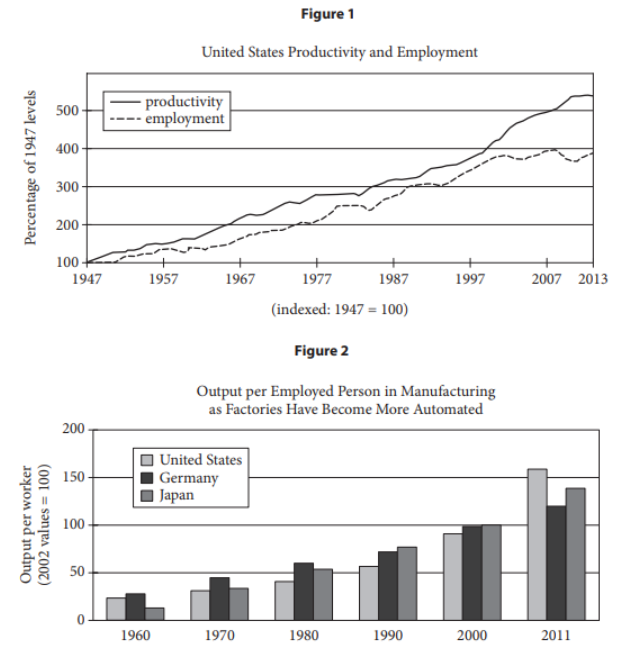After reading the passage choose the best answer to the given question based on what is stated or implied in the passage and in any accompanying graphics (such as a table or graph).
MIT business scholars Erik Brynjolfsson and Andrew McAfee have argued that impressive advances in computer technology—from improved industrial robotics to automated translation 5 services—are largely behind the sluggish employment growth of the last 10 to 15 years. Even more ominous for workers, they foresee dismal prospects for many types of jobs as these powerful new technologies are increasingly adopted not only 10 in manufacturing, clerical, and retail work but in professions such as law, financial services, education, and medicine. That robots, automation, and software can replace people might seem obvious to anyone who’s worked 15 in automotive manufacturing or as a travel agent. But Brynjolfsson and McAfee’s claim is more troubling and controversial. They believe that rapid technological change has been destroying jobs faster than it is creating them, contributing to the 20 stagnation of median income and the growth of inequality in the United States. And, they suspect, something similar is happening in other technologically advanced countries. As evidence, Brynjolfsson and McAfee point to a 25 chart that only an economist could love. In economics, productivity—the amount of economic value created for a given unit of input, such as an hour of labor—is a crucial indicator of growth and wealth creation. It is a measure of progress. On the 30 chart Brynjolfsson likes to show, separate lines represent productivity and total employment in the United States. For years after World War II, the two lines closely tracked each other, with increases in jobs corresponding to increases in productivity. The 35 pattern is clear: as businesses generated more value from their workers, the country as a whole became richer, which fueled more economic activity and created even more jobs. Then, beginning in 2000,the lines diverge; productivity continues to rise robustly, 40 but employment suddenly wilts. By 2011, a significant gap appears between the two lines, showing economic growth with no parallel increase in job creation. Brynjolfsson and McAfee call it the “great decoupling.” And Brynjolfsson says he is 50 confident that technology is behind both the healthy growth in productivity and the weak growth in jobs. It’s a startling assertion because it threatens the faith that many economists place in technological progress. Brynjolfsson and McAfee still believe that technology boosts productivity and makes societies wealthier, but they think that it can also have a dark side: technological progress is eliminating the need for many types of jobs and leaving the typical worker worse off than before. Brynjolfsson can point to a 55 second chart indicating that median income is failing to rise even as the gross domestic product soars. “It’s the great paradox of our era,” he says. “Productivity is at record levels, innovation has never been faster, and yet at the same time, we have a falling edian 60 income and we have fewer jobs. People are falling behind because technology is advancing so fast and our skills and organizations aren’t keeping up.” While technological changes can be painful for workers whose skills no longer match the needs of 65 employers, Lawrence Katz, a Harvard economist, says that no historical pattern shows these shifts leading to a net decrease in jobs over an extended period. Katz has done extensive research on how technological advances have affected jobs over the 70 last few centuries—describing, for example, how highly skilled artisans in the mid-19th century were displaced by lower-skilled workers in factories. While it can take decades for workers to acquire the expertise needed for new types of employment, he 75 says, “we never have run out of jobs. There is no long-term trend of eliminating work for people. Over the long term, employment rates are fairly stable. People have always been able to create new jobs. People come up with new things to do.” 80 Still, Katz doesn’t dismiss the notion that there is something different about today’s digital technologies—something that could affect an even broader range of work. The question, he says, is whether economic history will serve as a useful 85 guide. Will the job disruptions caused by technology be temporary as the workforce adapts, or will we see a science-fiction scenario in which automated processes and robots with superhuman skills take over a broad swath of human tasks? Though Katz 90 expects the historical pattern to hold, it is “genuinely a question,” he says. “If technology disrupts enough, who knows what will happen?”



 Get latest Exam Updates
Get latest Exam Updates 
 ×
×
















